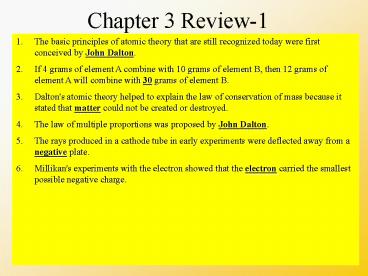Chapter 3 Review1 - PowerPoint PPT Presentation
1 / 9
Title:
Chapter 3 Review1
Description:
... theory that are still recognized today were first conceived by John Dalton. ... The law of multiple proportions was proposed by John Dalton. ... – PowerPoint PPT presentation
Number of Views:23
Avg rating:3.0/5.0
Title: Chapter 3 Review1
1
Chapter 3 Review-1
- The basic principles of atomic theory that are
still recognized today were first conceived by
John Dalton. - If 4 grams of element A combine with 10 grams of
element B, then 12 grams of element A will
combine with 30 grams of element B. - Dalton's atomic theory helped to explain the law
of conservation of mass because it stated that
matter could not be created or destroyed. - The law of multiple proportions was proposed by
John Dalton. - The rays produced in a cathode tube in early
experiments were deflected away from a negative
plate. - Millikan's experiments with the electron showed
that the electron carried the smallest possible
negative charge.
2
Chapter 3 Review-2
- In Rutherford's experiment, a very few of the
positively-charged particles were greatly
deflected as they passed through the metal. - The mass of the neutron is about the same as
that of a proton. - Most of the volume of an atom is made up of the
electron cloud. - The hydrogen isotope with the LOWEST mass is
named or called protium. - The hydrogen isotope with the HIGHEST mass is
named or called tritium. - Atoms of the same element can differ in mass
number, BUT NEVER in their atomic number. - The relative masses of all atoms are based on the
mass of one atom of carbon-12 isotope being equal
to 12 mass units.
3
Chapter 3 Review-3
- Neon has an atomic number of 10. Calcium has an
atomic number of 20. Compared to a mole of neon,
a mole of calcium contains the same number of
atoms. (6.022 x 1023 atoms) - All atoms of the same element have the same
number of protons and electrons. - Aluminum-28 has as atomic number of 13. How many
neutrons does this isotope have? 15
(28-1315) - Carbon-12 has 6 neutrons. What is the atomic
number of carbon-12? Atomic number 6 amu - Sulfur has an atomic number of 16. What is the
mass number of the isotope contain 15 neutrons?
31 (16 protons 15 neutrons) - As the mass number of the isotopes of a
particular element increases, the number of
protons remains the same.
4
Chapter 3 Review-4
- Phosphorus-32 has an atomic number of 15. How
many neutrons does this isotope have? 17
(32-15 17 neutrons). - Silicon-31 contains 14 protons. How many
electrons does an atom of silicon 31 contain?
14 electrons (protonselectrons). - The smallest particle of an element that can
exist either alone or in combination with the
smallest such particles of elements is called an
atom. - The negatively charged subatomic particles that
surround or orbit the nucleus are called
electrons. - The short-range attractive forces that hold the
nuclear particles together are called nuclear
forces. - Atoms of the same element that have different
masses are called isotopes and nuclides.
5
Chapter 3 Review-5
- The number of protons in the nuclei of the atoms
of a particular element is referred to as the
atomic number. - The weighted average of the atomic masses of the
naturally occurring isotopes of an element is
referred to as average atomic mass. - The amount of a substance that contains a number
of particles equal to the number of atoms in
exactly 12 g in a carbon- 12 is referred to as a
mole. - The mass in grams of one mole of an element in a
compound is referred to as the molar mass of the
atom. - The electrically neutral, subatomic particles
found in the nuclei of atoms are called neutrons. - ALL sub-atomic particles found in the nucleus of
an atom are called nucleons.
6
Weighted Average Problem
- U-234 percentage of occurrence ( 0.005 ),amu
234.041 - U-235 percentage of occurrence ( 0.720 ),amu
235.043 - U-238 percentage of occurrence ( 99.275
),amu 238.051
(mass number x decimal of occurrence) (mass
number x decimal of occurrence) (mass number x
decimal of occurrence) weighted average
atomic mass
Solution (0.00005 x 234.041) (0.0072 x
235.043) (.99275 x 238.051) (0.00117)
(1.692)
(236.325) 238.018 amu
7
Atomic Chart
8
Short Essay Questions
- A. Know the Five major proposals of Dalton's
theory - All matter is made up of extremely small
particles called atoms. - Atoms of the same type of matter are identical in
size, mass and other properties. - Atoms can not be broken down into smaller
particles, or be created or destroyed. - Atoms of unlike elements combine in simple whole
number ratios to form chemical compounds. - In chemical reactions, atoms are combined,
rearranged or separated.
9
Short Essay Question 2
- List, define and describe the three subatomic
particles that make up the atom. - Electrons negatively charged, very light mass
1/1840th of a proton orbit the nucleus, most of
the volume of the atom comes from the electron
cloud. - Protons positively charged, located in the
nucleus, identifies the type of atom, contributes
to the mass of the atom about equal in mass to a
neutron. - Neutrons no charge located in the nucleus,
contributes to the mass of the atom responsible
for radioactivity and isotopes.































